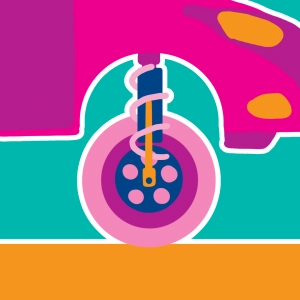 Truck shock absorber
Truck shock absorber
Learning objectives
- To understand how a shock absorber works.
- To play with the parameters to observe the nature of the oscillations and the phenomenon of resonance.
- To have a qualitative study of an oscillating system.
- To define transitional regime, steady state, harmonic regime.
The shock absorber is an important safety element. The primary goal is to maintain contact with the road rather than passenger comfort. Fortunately, these two objectives are achieved under the same conditions. To study how a vehicle behaves when faced with a disturbance such as a pothole or a curb, we can model this physical system as a mass + spring + damping. The study of such a system teaches us that there are only three types of responses to such an impulse (disturbance). The three regimes of transient responses are :
- Pseudoperiodic regime: The vehicle undergoes oscillations before returning to its equilibrium position. This is the consequence of a stiffness constant that is too low and/or damping that is too weak.
- Aperiodic regime: The vehicle does not oscillate. It returns to its equilibrium position after a potentially long time, following an exponential curve. This type of response is the consequence of a stiffness constant that is too high and/or damping that is too strong.
- Critical regime: This regime is located just at the transition between the previous two. It is an aperiodic regime (without oscillation) with the shortest return time to normal.
One might imagine that the last regime should be preferred. However, experience shows that it is preferable to tolerate a small oscillation, and the optimal setting turns out to be a pseudoperiodic regime close to the critical regime.
Despite all the care we can take in adjusting the values of k (stiffness constant) and c (damping coefficient), the shock absorber will not be able to play its role for all excitation frequencies. Another study is necessary. This is the study of the sinusoidal steady state, also called "harmonic study." It allows, in particular, to identify the resonance frequency, which characterizes the frequency at which the amplitude of oscillations is most intense, at the risk of breaking the shock absorber or the axle. To learn more about this study, watch the eduMedia animation on shock absorbers - harmonic regime.

Discover EduMedia for free
The interactive encyclopedia that brings science and math to life in the classroom.
Over 1,000 resources





